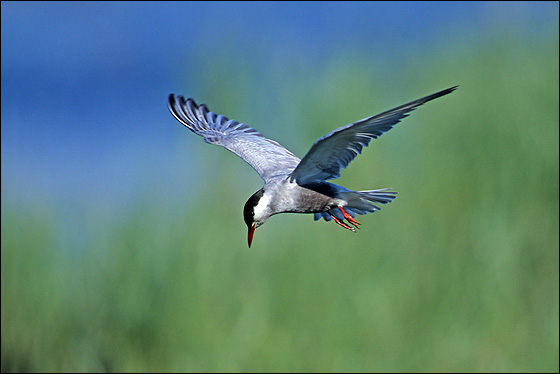A fussy species which likes the sun on its back, the Whiskered Tern is the patchiest in distribution of the Marsh Terns, occurring mainly in the catchments and deltas of a few mighty rivers such as the Volga, Danube and Guadalquivir. Here it breeds in the usual Marsh Tern habitat, still or slow-flowing water with copious floating vegetation, although it will also take to man-made habitats such as fishponds and rice fields. Its food is similar to that of the other Marsh Terns, consisting more of insects than of fish, and with the occasional amphibian, such as a newt thrown in.
Whiskered Terns do, though, have their own distinctive feeding technique. More often that not they simply fly up and down over the same patch of water again and again, usually into the wind and only 2-4 m above the surface. When they see something they break the Marsh Tern mould by plunging down to the surface, getting their feet and bellies wet, and then resume their quartering. They also regularly dip down to the surface to snatch an item without immersing, and will sometimes catch beetles by dropping on to them on the ground.
Most European colonies are small, with fewer than 20 pairs. In fact, should a colony ever exceed more than a few pairs the birds will divide themselves, somewhat antisocially, into discrete sub-colonies with synchronised breeding. Whiskered Terns are equally snooty towards other species, too, because although they often nest alongside Black-headed Gulls and other Marsh Terns, they won’t actually mix with them. The only exception to this appears to be grebes. In Central Europe Little, Great Crested, Red-necked and Black-necked Grebes may all be drawn to Whiskered Tern colonies like fans to a pop star’s home, nesting there in preference to anywhere else. The grebes obtain safety by breeding close to the aggressive terns, but it’s not all to their advantage. The terns sometimes take over the grebes’ floating nests, and at times the broods may be mixed, leading to confusion all round.

